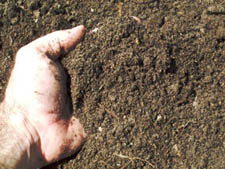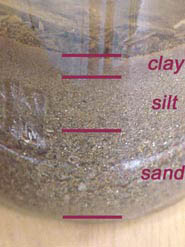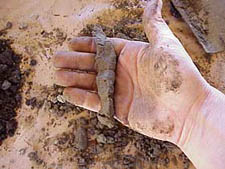
The soul of your garden is the soil. A healthy soil translates into a healthy garden. But before you begin adding compost, manure, fertilizer, lime, and other soil amendments, you need to know what type of soil you have and its properties. Clay, silt, and sandy soils all behave differently and have different needs.
Here's some information on your soil texture and structure, and some simple home tests you can do to determine the type of soil you have and it's health.
Soil Texture: What You Inherit
Soil is comprised of air spaces and organic matter, but mostly mineral particles. There are three kinds of soil minerals: sand, silt and clay. The relative percentage of each of these particles in the soil determines its texture. Soil texture won't change unless you literally excavate your soil and replace it.Sand has the largest soil particles (.4- to .01-inch diameter) and the largest pores between particles. A soil with 50 percent sand tends to drain well and, dry out and warm up quickly, but it also tends to be less fertile and it doesn't hold moisture well throughout the season.
Silt soil particle size is between clay and sand (.01- to .0001-inch diameter). The characteristics of silty soil are similar to those of clay, but are moderated by its larger particle size.
Clay soil has the smallest soil particles (less than .0001-inch diameter) and the least amount of water and air spaces between particles. Consequently, a soil with at least 50 percent clay will have all the opposite characteristics of sand. It drains, dries out, and warms up slowly, but is very fertile and, once wet, holds water well.

Using a jar test, you can determine the percentage of clay, silt and sand in your soil.
Soil Structure: What You Make
The way sand, silt, and clay particles are grouped together in aggregates is called the soil structure. The size and arrangement of these aggregates influence the nutrient availability and drainage of the soil.Whether you have dry, sandy soil; silty soil; or wet, heavy clay soil, adding organic matter in its many forms will improve the soil structure. The ideal amount of organic matter in most soils is between 5 percent and 10 percent. Organic matter helps any soil become more like the ideal loamy soil. Here's how.
Microorganisms feed on organic matter and produce polysaccharides. Polysaccharides help form humus, which enables small clay or silt particles to stick together to form larger aggregates. Larger aggregates create more pores for water and air to flow. The soil drains better, the plants grow better because of the increased pore space, and more nutrients are available.
In sandy soils, humus acts like a sponge to catch and hold moisture. Humus also helps accumulate nutrients, making a sandier soil more fertile.
Soil pH: Acid or Alkaline?
The pH of soil is a measure of the sweetness (alkalinity) and sourness (acidity) of the soil. It is measured on a scale of 1 to 14. A soil pH below 7.0 is considered acid; above 7.0 is alkaline. The correct pH for your plants is important because certain nutrients are only available to plants within a specific pH range. Usually areas of high rainfall have a low pH and areas of low rainfall have a high pH.Soil Texture
The ideal soil texture is loam. It is composed of 40 percent sand, 40 percent clay, and 20 percent silt. You can determine the texture of your soil using two tests below. The ribbon test will determine the percentage of clay in your soil, and the jar test shows approximate proportions of sand, silt, and clay.In all cases, adding organic matter in the form of leaves, hay, grass clippings, or compost will make a sandy soil hold more water and nutrients and be more fertile. Organic matter will also make clay soil easier to work and drain better. Apply a 4- to 6-inch-deep layer of grass clippings, hay or leaves in fall to decompose over winter or a 1- to 2-inch-deep layer of finished compost in spring before planting and work it into the soil.Soil Structure
The ideal structure of topsoil (at least 10 to 12 inches deep) is granular, crumb-size groupings of soil particles and plenty of pore spaces. The ideal subsoil structure is blocky, with cubes of soil and vertical openings. Compacted soil has few air and water pore spaces and tends to be poorly drained.Compacted soils in perennial beds will benefit from a yearly 1- to 2-inch-deep top-dressing of compost. A compacted layer in annual beds can be broken up by double digging or deeply tilling the soil below the hardpan layer and mixing in generous amounts of organic matter. In some soils the thickness of the hardpan layer may require building raised beds or planting in a different location.
Some gardeners have shunned tilling their annual gardens because it disrupts the natural soil structure. No-till gardening is a way to grow plants without tilling. Simply add organic matter and only work the top layers of the soil enough to plant seeds or plants.

Create a "ribbon" with your soil to determine how much clay it contains.
Five Soil Tests
Here are five home tests you can conduct on your own to help you determine your soil texture, drainage, and pH.Ribbon Test. Take a handful of moist soil and roll it in your hand to the size of a ping-pong ball. Squeeze the soil ball between your thumb and fingers in the palm of your hand to make a ribbon. Stand the ribbon straight up in the air. If you can't form a ribbon, then the soil is at least 50 percent sand and has very little clay. If the ribbon is less than 2 inches long before breaking, then your soil has roughly 25 percent clay in it. If it is 2 to 3-1/2 inches long, then it has about 40 percent clay. If the ribbon is greater than 3-1/2 inches long and doesn't break when held up in the air, then it is at least 50 percent clay.
Jar Test. Put 1 inch of dry, crushed garden soil in a tall quart jar. Fill the jar 2/3 with water and add 1 teaspoon of a dispersing agent such as Calgon or table salt. Shake the jar thoroughly and then let the contents settle. Sand will settle to the bottom in about one minute. Measure the depth of that layer. Silt will settle in 4 to 5 hours. You should see a color and size difference between the sand and silt layers. If not, measure the depth of both layers and subtract the sand depth from the total to determine the silt depth. The clay takes days to settle. Determine its depth in the same way as for the silt. Some of the smallest clay particles may remain permanently in suspension and will not settle out.
By measuring the depth of each layer of soil particles, you can figure the percentage of sand, silt, and clay in your soil. For example, if you have a 1/4-inch-deep layer of sand on the bottom and the overall depth of the soil in the jar is 1 inch, then your soil has about 25 percent sand in it.
Percolation Test. Dig holes 1 foot deep by 2 feet wide in various places in your garden or landscape. Cover the holes with plastic to let the soil dry out. Once it's dry, fill the hole to the top with water and time how long it takes for the water to completely drain. The ideal time should be between 10 and 30 minutes. If the water drains in less than 10 minutes, then your soil will tend to dry out quickly in summer. If it takes 30 minutes to 4 hours to drain, you can still grow most plants but will have to water slowly to avoid runoff and to allow the water to soak deeply. If your soil takes longer than four hours to drain, you may have a drainage problem.
One caveat: Extremely dry soils, especially those with large amounts of clay, tend to crack. The water in the drainage test will leave quickly because of these cracks, not because of good structure.
Compaction Test. The simplest way to see if your soil has a hardpan or compaction layer below the surface is to take a metal rod and walk around your property sticking it into the ground. If you can't easily push the rod into the soil at least 6 to 8 inches deep, then you need to improve the aeration of your soil. If you push it down and consistently meet resistance at a certain depth, then there may be a hardpan layer.
To further check for a compaction layer, dig a 1- to 2-foot-deep hole in the garden and look at the profile. A hardpan appears as a horizontal layer of soil that looks denser with less crumbly soil particles than the topsoil, has few roots or earthworms, and may even be a darker color than the rest of the soil.
Another way to tell if you have a hardpan layer is to dig up a plant and examine the roots. If they're white, vigorous, and well branched and extend at least 6 to 8 inches deep, then your soil has good structure. If the roots are 1 to 2 inches deep, mushy, and gray colored, they are infected with a bacterial rot. If they are shallow, brittle, and black, they're infected with a fungal rot. Both diseases are enhanced by poor drainage either from a high water table or a compaction layer.
pH Test. To check if your soil is severely alkaline, take 1 tablespoon of dried garden soil and add a few drops of vinegar. If the soil fizzes, then the pH is above 7.5. The free carbonates in the soil react with the acid at a pH of 7.5 and above.
To check for acidity in the soil, take 1 tablespoon of wet soil and add a pinch of baking soda. If the soil fizzes, then the soil is probably very acidic (pH less than 5.0). The ideal pH for most plants is 5.5 to 7.5. A few plants prefer more extreme conditions. Try this remedy for acidic or alkaline soil: If your pH is on the extreme end of either range, take a soil test to determine the exact pH. Add the appropriate amounts of limestone (for acidic soils) and sulfur (for alkaline soils), according to the soil test. http://www.garden.org/ediblelandscaping/?page=soil-common-sense
No comments:
Post a Comment